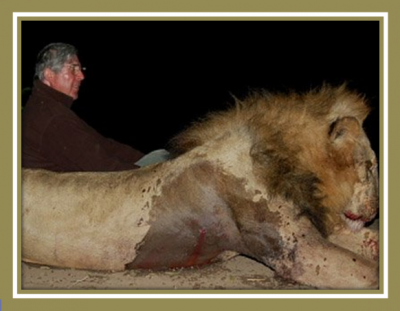|

British banker Sir David Scholey and his Zambian lion trophy in 2011
It was recently announced by Zambia’s Minister of Tourism and Arts, Jean Kapata, that a quota of 24 lions will be issued for the 2016 hunting season.
Previously, on 10th January 2013, Zambia announced a moratorium on lion hunting based on a number of concerns, among which were:
1. Declining lion populations in some areas due to indiscriminate and “over-harvesting”;
2. Unreliable statistics on which to base quotas.
Despite the above concerns remaining in force, it was announced by the European Union’s “Scientific” Review Group on April 7th that Zambian lion trophies would be welcome in Europe. The USA, on the other hand, maintains a ban on such trophies unless and until Zambia can convince the US Fish and Wildlife Service that lion trophy hunting is beneficial to the survival of the species in Zambia.
The divergence of opinion between the EU and the USA about allowing trophy hunting imports of Zambia’s lion trophies is interesting, and will form the basis for a later blog on this site.
But let’s have a look at why Zambia decided to reverse an earlier moratorium on lion trophy hunting.
It certainly did not result from any proper understanding of lion populations in hunting concessions. A study based on latest information about Zambian lion populations requested by the EU and provided by the UNEP World Conservation and Monitoring Centre (that claims to provide “objective, scientifically rigorous products and services”) on August 2015 mentions the following:
1. The estimated lion population in the three largest national parks in Zambia was as follows – Kafue- 264, South Luangwa – 94, Lower Zambezi – 11-34.
2. The South Luangwa lion population was declining, had low recruitment, low subadult and adult male survival, depletion of adult males, and a senescing female population. The primary cause of male mortality was considered to be trophy hunting with 46 of the park’s male lions having been shot between 2008-2012.
3. Hunters were reported to be using baits along the park boundaries to provide trophies for their clients – refer to point 2 above.
To which I would add the following information:
1. Zambia’s minister earlier announced earlier that there were 4,000 lions in the country. She had to be corrected by the wildlife department to say that there could be 1,500 – 2,500 lions, but the basis of this estimate was unclear – see actual data from WCMC above.
2. The total population of Zambia’s lion population in protected areas is not likely to exceed 500 individuals of both sexes and all ages. There are no reliable counts of lions resident in hunting concessions, and as stated above the only means hunters can “harvest” lions is by relying on the protected populations to provide their quotas. Remember that Zambia’s hunting concessions border directly onto the national parks.
3. During the nine years 2005-2013, CITES records indicate that Zambia exported a minimum total of 567 male lions (average of 63 per year, maximum of 89 in 2010). Of that total, 302 (or 53%) went to the USA, and the major importing countries in the EU included Spain, France, Germany, Denmark, Hungary and the UK. Such rates of offtake are clearly unsustainable and have resulted in the dire status of Zambia’s currently remaining lions.
4. Trophy male lions constitute about 10% of the average lion population. A “sustainable” harvest rate of lions is estimated at about 8% of males per annum. With the proposed quota of 24 adult male lions per annum, Zambia assumes that the total lion population in hunting areas (lions in national parks are not to be counted) of 3,000 lions! That is a complete nonsense.
5. Zambia has no Lion Conservation Management Plan signed by government. Such lion plans were required by the CITES Animals Committee to allow further exports in compliance with CoP 2004. So why does CITES allow trophy exports from Zambia in absence of a lion conservation plan?
So where do we go from here?
Clearly the EU SRG ignored all the information provided by the commissioned WCMC report to reach their conclusion to allow imports of lion trophy hunting imports into the EU.
Clearly Zambia is being reckless in allowing a “sustainable” quota of 24 male lion trophies per annum from a lion population in sharp decline. One could say that this is better than the excessive quotas of the past, but there is not one iota of scientific evidence to support any further trophy hunting of lions in Zambia under the guise of “sustainability”.
National elections are to be held in Zambia on August 11th. Perhaps we can hope that the election will vote people in who have a more conservation minded view of how Zambia’s wildlife resources should benefit their citizens rather than the current “kill for profit” formula that has failed conservation for so many years?
Picture credit: News Group Newspapers Ltd
|




